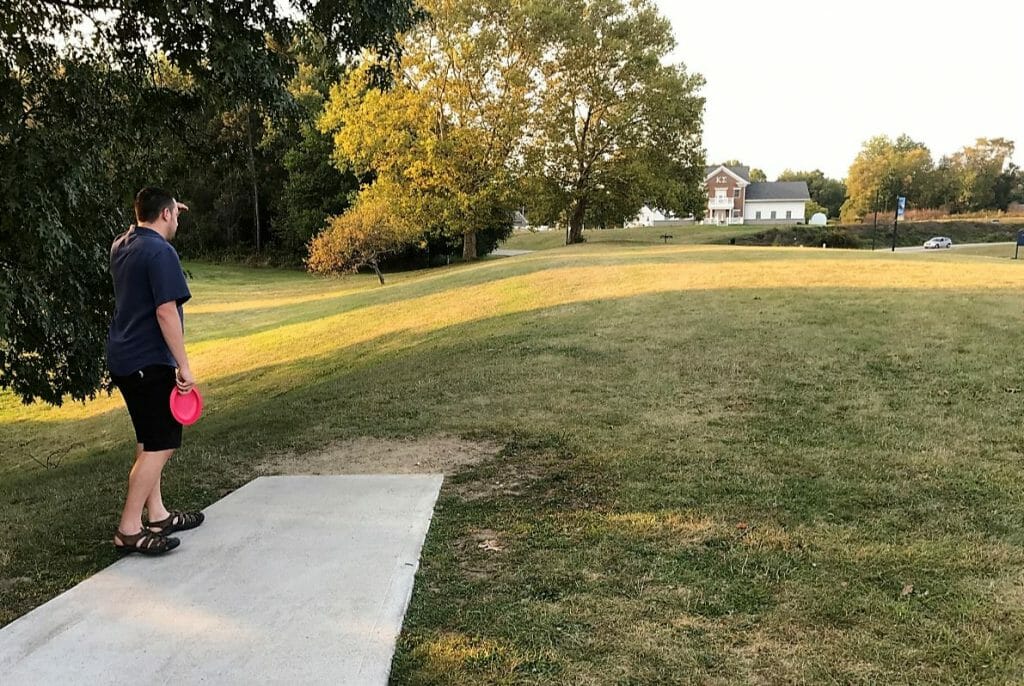Hone your inner rangefinder for more success on the course
September 19, 2017 by Matt Rothstein in Instruction with 0 comments

“The shortest distance between two points is an ace.”
-Euclid, Elements
Disc golf is a game of distances. Remove everything else — the fairways, hazards, sweeping elevation changes, wind gusts and guardian trees — and what remains is simple, Euclidean space.
Tailoring your practice routine to develop a better sense of distance on the course will help clarify your game plan, improve your shot selection, and execute your shots more consistently. So for this installment of our Tuesday Tips series, we’ll look at three practice drills that you can use to hone your inner rangefinder1.
Drill 1: End Zone to End Zone
What you’ll need: Six distance or fairway drivers and a football/soccer/rugby field.
Practicing your long game on a well-marked athletic field provides a great point of reference for developing distance accuracy. You’ll get to know how far your best drives go, how far your shanks go, and what it feels like to execute various distances.
For this drill, you will start behind one goal line and throw each of your six drivers toward the opposing goal line. When you have finished, retrieve your six discs while counting how many have gone beyond the opposing goal line without going wide of the sidelines. Repeat this procedure three times while tracking your score out of a possible 18 throws. You can change things up by practicing with a variety of shots: forehands, flex-shots, hyzers, rollers, etc. Add or reduce distance by moving in front or behind the goal line to adjust to your ability level.
Drill 2: Get Up, Get Up, and Get Down
What you’ll need: One basket, three cones/markers, three midranges, and three putters
Big drives are flashy, and big putts make noise, but executing well-placed approach shots is where so much of the heavy lifting is done on the course. Developing a better sense of distance on your midrange shots will help you get up and down more consistently, take pressure off your putting, and recover more often from wayward tee shots.
For this drill, set three cones at the following distances from a basket: 40 paces (approximately 120 feet), 60 paces (180 feet) and 80 paces (240 feet). Begin at the cone nearest to the basket and throw an approach shot toward the pin. Proceed next to the middle cone, throw another approach, and then out to the furthest cone for your third approach shot. Next, walk to each of your three lies, beginning at the furthest from the basket, and stop at each lie to throw a putt. Only count those approach shots that result in a made putt. Continue through this cycle six times, tracking your score out of a total 18 attempts.
Again, you can practice a variety of shots, or challenge yourself by placing obstacles around the basket to make good placement of the approach shot even more essential.
Drill 3: Putting Cycles
What you’ll need: One basket, one putter
Judging distances at close range may seem like a no-brainer, but it also requires much greater precision than longer-range estimates. How many putts, after all, come down to a matter of only one or two inches?
For this last drill, I am recycling material from a previous post:
Begin at the basket and step-off six paces in any direction. Throw your putt, and then proceed to the basket to retrieve. Next, step-off eight paces. Putt, retrieve, and, finally, walk out to 11 paces, where you will be outside the 10-meter circle and jump putts are allowed. Repeat this cycle of putts from the three locations a total of six times, keeping track of your score out of the total possible 18.
After a few weeks, not only should you be able to estimate the distance of any putt to within a foot or two, but you will also have trained your body, through muscle memory, to be able to produce the appropriate amount of power for the shot.
Each of these three drills was designed to give you a better sense of distance. One way to make the exercises more effective is to add pressure, and one way to do this is by tracking your scores and your progress. If you use a scoring app like UDisc, try adding these exercises as custom courses and then entering your score like you would any other round. Tracking personal benchmarks like your scoring average, best score, and worst score can help bring the stress of a competitive round to your practice sessions.
A note on rangefinders: In 2013 the PDGA approved the use of laser rangefinders, allowing players to get precise readings of distances during sanctioned play. Don’t let this discourage you from developing your own sense of distance — there is still a 30 second shot clock (see PDGA Rules Section 804.01) to abide by, and a good sense of distance will help you recognize when the reading from a rangefinder is incorrect. ↩